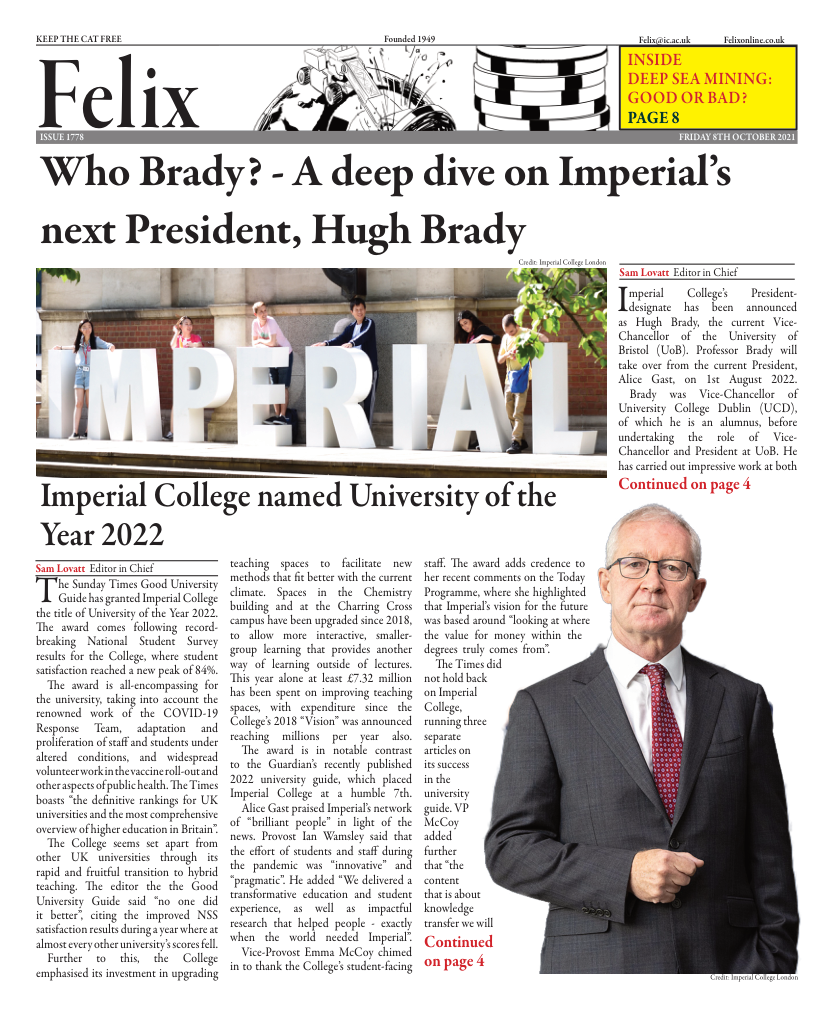Deep-sea mining: menace to the oceans or a new hope?
Proponents of deep-sea mining argue t provides an environmentally friendly alternative to terrestrial mining. However, others believe that too much is still unknown about the deep sea.

In June of this year, Nauru, a small Pacific island nation about the size of Camden, informed the UN’s International Seabed Authority (ISA) of its plans to mine the seabed in its surrounding waters. By doing so, it triggered a clause, giving the ISA two years to finalise the regulations governing deep-sea mining. Nauru is sponsoring a subsidiary of The Metals Company (TMC), a deep-sea mining enterprise, which intends to mine small potato-shaped deposits of metal, known as polymetallic nodules, from the seabed. If the ISA does not meet its two-year deadline, TMC will be allowed to proceed with its mining operations, with whatever regulations are in place by that time.
Proponents of deep-sea mining argue that it provides an environmentally friendly alternative to terrestrial mining techniques, and that, with demand for batteries and electronic components rising, we must inevitably look to the oceans for the metals which we so desperately need. However, many influential scientists and policymakers believe that too little is known about the deep sea, and that a more thorough review into deep-sea mining must be taken before venturing further.
It has become clear over the past few decades that if we as humans are to mitigate the impact of climate change, we must transition to cleaner, renewable energy sources, and redesign our energy, transport, and manufacturing systems. Wind turbines, solar and hydropower, and electrified transport all require large quantities of metals. Commodities such as copper, cobalt, manganese, and nickel are used in electrical components and most importantly, in batteries.
At present, these metals are primarily obtained from terrestrial mines, which come with their own problems. Take for example, cobalt. One of its main uses is in lithium-ion batteries. With the surge in electric vehicle (EV) sales, demand for cobalt is rising, and is likely to increase further as diesel and petrol vehicles are phased out. The World Economic Forum has estimated that demand will increase by a factor of four in 2030, compared with 2019 levels. Over 70% of the world’s cobalt supply is mined in one country – the Democratic Republic of Congo, where major concerns have been expressed about forced child labour, amongst other things. In 2019, 14 Congolese families filed a lawsuit stating that their children had been forced to work in the mines and had been killed or maimed due to hazardous conditions.
Additionally, land-based metal extraction can cause soil, water, and air pollution, and in humans, can cause a whole host of cardiovascular issues. The impact on local wildlife is also severe; gold mining in Brazil has led to increased mercury levels in fish. Whilst legislature exists to regulate mining in developed countries, the same is not always true in the developing world, where mines are often located.
This, claim proponents, is where deep-sea mining comes in. Polymetallic nodules contain copper, cobalt, manganese, and nickel, which, as stated earlier, are essential for batteries and electronics. Most deep-sea mining operations will work using what is known as a ‘continuous bucket line’ system:
1)Collector vehicles tethered to a large surface ship scour the seabed, removing the top 10-15cm of the seabed and collecting the nodules (metal deposits).
2)Pipes attached to the vehicles transport the nodules to the surface vessel, where they are separated from the sediment.
3)The sediment is discharged to the ocean.
4)The nodules are transported to the shore, where they are processed.
Deep-sea mining companies claim that the process is not only necessary, but critical, to fulfil the demand for batteries required for the transition to clean energy. According to MIT, the region of ocean between Hawaii and the mainland USA alone contains “around six times more cobalt and three times more nickel than all known land-based stores”.
The companies argue that the sooner we start mining the ocean depths, the better. TMC, which is working with Nauru, through its subsidiary, Nauru Ocean Resources Inc. (NORI) says that “unlike land ores, [nodules] don’t contain toxic levels of heavy elements and producing metals from nodules generates 99% less solid waste, with no toxic tailings.”
Many scientists are, however, sceptical. The claim of no toxic tailings is hard to verify, but many scientific reports are to the contrary. A multidisciplinary research project, known as MIDAS, found in 2016, that it was difficult to predict resource toxicity in advance, and that mineral deposits would have to be assessed independently to determine toxic risk. However, what is highly likely is that deep-sea mining would alter the ecosystem of the deep sea, potentially resulting in a loss in biodiversity. The sediment, discharged from surface vessels could disperse far and wide, and create standing midwater plumes. Combined with light and sound pollution, this could severely affect marine life. Furthermore, the ocean acts as a carbon sink, and the impact on deep-ocean carbon storage is unknown.
Looking into existing research, what is most clear is that the precise impact of deep-sea mining is ambiguous. This is both because the technology for deep-sea mining is relatively new, and because the depths of the ocean are still being explored. It is for this reason that many scientists and conservationists, including figures such as David Attenborough, are against it for the present time. 571 marine experts and policymakers have signed a letter calling for a temporary moratorium on the practice until scientists have had time to rigorously determine its impacts. Accompanying them, BMW, Volvo, Google, and Samsung have also pledged to exclude minerals sourced via deep-sea mining from their supply chain, much to the disdain of the mining companies. The UK’s current official position is aligned with this too.
In the meantime, the ISA have already issued 31 fifteen-year contracts for deep-sea exploration. There is still some time before deep-sea mining happens in practice; in addition to finalising the regulations, exploitation licenses must be granted to contract holders. This process could take two to three years, in addition to the two years for regulations to be drafted. Even in this time, it is not possible to fully explore the potential impact of deep-sea mining on the seabed and its ecology. Whether a moratorium is agreed, or the ISA pushes ahead with its regulations, it is clear that the decisions made by policymakers will be hugely important and have long-lasting effects on our planet and our transition to renewable energy.








